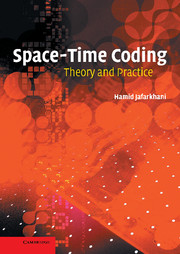Book contents
- Frontmatter
- Contents
- Preface
- Standard notation
- Space-time coding notation
- List of abbreviations
- 1 Introduction
- 2 Capacity of multiple-input multiple-output channels
- 3 Space-time code design criteria
- 4 Orthogonal space-time block codes
- 5 Quasi-orthogonal space-time block codes
- 6 Space-time trellis codes
- 7 Super-orthogonal space-time trellis codes
- 8 Differential space-time modulation
- 9 Spatial multiplexing and receiver design
- 10 Non-orthogonal space-time block codes
- 11 Additional topics in space-time coding
- References
- Index
4 - Orthogonal space-time block codes
Published online by Cambridge University Press: 14 August 2009
- Frontmatter
- Contents
- Preface
- Standard notation
- Space-time coding notation
- List of abbreviations
- 1 Introduction
- 2 Capacity of multiple-input multiple-output channels
- 3 Space-time code design criteria
- 4 Orthogonal space-time block codes
- 5 Quasi-orthogonal space-time block codes
- 6 Space-time trellis codes
- 7 Super-orthogonal space-time trellis codes
- 8 Differential space-time modulation
- 9 Spatial multiplexing and receiver design
- 10 Non-orthogonal space-time block codes
- 11 Additional topics in space-time coding
- References
- Index
Summary
Introduction
In this section, we study the design of space-time block codes (STBCs) to transmit information over a multiple antenna wireless communication system. We assume that fading is quasi-static and flat as explained in Chapter 2. We consider a wireless communication system where the transmitter contains N transmit antennas and the decoder contains M receive antennas. We follow our notations in Equation (2.1) for the input–output relation of the MIMO channel. The goal of space-time coding is to achieve the maximum diversity of N M, the maximum coding gain, and the highest possible throughput. In addition, the decoding complexity is very important. In a typical wireless communication system the mobile transceiver has a limited available power through a battery and should be a small physical device. To improve the battery life, low complexity encoding and decoding is very crucial. On the other hand, the base station is not as restricted in terms of power and physical size. One can put multiple independent antennas in a base station. Therefore, in many practical situations, a very low complexity system with multiple transmit antennas is desirable. Space-time block coding is a scheme to provide these properties. Despite the name, a STBC can be considered as a modulation scheme for multiple transmit antennas that provide full diversity and very low complexity encoding and decoding.
- Type
- Chapter
- Information
- Space-Time CodingTheory and Practice, pp. 55 - 109Publisher: Cambridge University PressPrint publication year: 2005
- 2
- Cited by



